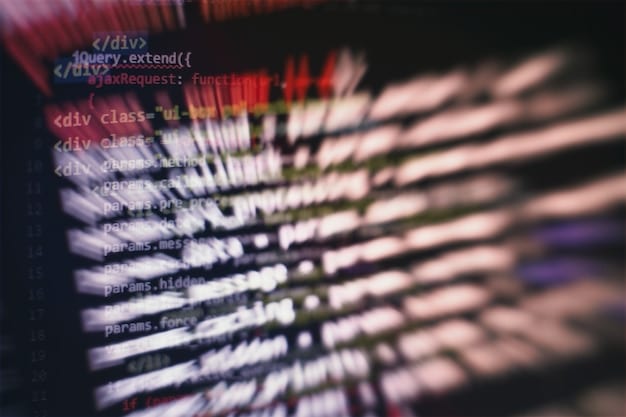The Ethics of Deepfakes in Political Reporting: A Critical Examination

Anúncios
The ethics of deepfakes in political reporting involves critically examining the potential for manipulated media to mislead the public, erode trust in legitimate sources, and undermine democratic processes through disinformation and deceptive content.
Anúncios
The rise of deepfake technology presents unprecedented challenges to political reporting. This article delves into the ethics of deepfakes in political reporting: a critical examination, exploring the potential for manipulation and the responsibilities of journalists in this new landscape.
Understanding Deepfakes: A Primer for Political Observers
Deepfakes, synthetic media in which a person in an existing image or video is replaced with someone else’s likeness, have rapidly evolved from a technological novelty to a potent tool for misinformation. Understanding their mechanics and potential impact is crucial for anyone involved in political discourse.
Anúncios
What are Deepfakes?
Deepfakes utilize artificial intelligence, particularly deep learning techniques, to create highly realistic but fabricated videos and audio recordings. These manipulated media can make it appear as though someone said or did something they never actually did, blurring the lines between reality and fiction.
The Technology Behind the Illusion
The creation of deepfakes involves training AI algorithms on vast datasets of images and videos. These algorithms learn to mimic a person’s facial expressions, voice, and mannerisms, allowing them to seamlessly insert that person’s likeness into another video or audio clip. Advances in AI have made this process increasingly accessible and the results increasingly convincing.

The implications of this technology are far-reaching, especially in the realm of political reporting. Here are some key aspects to consider:
- Accessibility: Deepfake technology is becoming increasingly accessible, with user-friendly software and online tutorials lowering the barrier to entry for individuals and groups with malicious intent.
- Realism: The realism of deepfakes is rapidly improving, making it more difficult for the average person to distinguish them from authentic media.
- Scalability: Deepfakes can be rapidly disseminated across social media platforms, reaching vast audiences in a short amount of time.
In summary, deepfakes pose a significant threat to the integrity of information in the political sphere. Their accessibility, realism, and scalability make them a powerful tool for spreading misinformation and manipulating public opinion.
The Ethical Minefield: Deepfakes and Journalistic Responsibility
For journalists, deepfakes present a unique ethical challenge and are forcing media organizations to re-evaluate existing practices. Traditional journalistic principles of accuracy, fairness, and transparency are now being tested in unprecedented ways.
Fact-Checking in the Age of AI
Traditional fact-checking methods are often insufficient to detect sophisticated deepfakes. Journalists must rely on advanced techniques, such as forensic analysis of video and audio, to verify the authenticity of media before dissemination.
Reporting on Deepfakes: A Delicate Balance
Reporting on deepfakes requires a delicate balance between informing the public about their existence and potential dangers, and inadvertently amplifying their impact by sharing or describing them in detail. The wrong approach could easily facilitate the spread of disinformation.
Navigating the ethical minefield of deepfakes requires a proactive, multi-faceted approach. Consider the following guidelines:
- Transparency: Be transparent with the audience about the potential for deepfakes to influence political discourse.
- Verification: Implement rigorous verification processes to authenticate media before publishing or broadcasting.
- Context: Provide context and analysis when reporting on deepfakes, explaining their potential impact and the motivations behind their creation.
- Debunking: Actively debunk deepfakes by providing accurate information and evidence of manipulation.
Ultimately, the ethical responsibility of journalists is to protect the public from being misled by deepfakes. This requires a commitment to rigorous fact-checking, transparent reporting, and a willingness to adapt to the evolving technological landscape.
The Impact on Political Discourse: Eroding Trust and Manipulating Opinion
The proliferation of deepfakes has profound implications for political discourse. The ability to manipulate public opinion through fabricated media can erode trust in legitimate sources of information and undermine democratic processes.
Undermining Credibility
Deepfakes can be used to discredit political opponents by creating false narratives and associating them with controversial statements or actions. Even if a deepfake is quickly debunked, the initial damage to a politician’s reputation can be difficult to repair.
Polarization and Division
Deepfakes can exacerbate political polarization by reinforcing existing biases and creating echo chambers. Manipulated media can be targeted at specific demographic groups, stoking division and mistrust between different segments of society.

The effects of deepfakes on public opinion are complex and multifaceted. Here are a few key considerations:
- Confirmation Bias: Deepfakes can exploit confirmation bias by presenting fabricated information that aligns with people’s existing beliefs, making them more likely to accept it as true.
- Emotional Appeal: Deepfakes can be designed to evoke strong emotional responses, such as anger or fear, which can impair critical thinking and make people more susceptible to manipulation.
- Social Influence: Deepfakes can be disseminated through social media networks, where they can be amplified by social influence and peer pressure.
In conclusion, the impact of deepfakes on political discourse is significant. The ability to erode trust, polarize society, and manipulate public opinion poses a serious threat to the health and stability of democratic institutions.
Legal and Regulatory Frameworks: Addressing the Deepfake Threat
The increasing prevalence of deepfakes has prompted calls for legal and regulatory frameworks to address the threat they pose. However, striking the right balance between protecting freedom of speech and preventing the spread of misinformation is a complex challenge.
Existing Laws and Regulations
Some existing laws and regulations, such as defamation laws and laws against voter suppression, can be applied to address certain aspects of deepfake misuse. However, these laws were not specifically designed to address the unique challenges posed by this technology.
Proposed Legislation
Several legislative initiatives have been proposed to specifically target deepfakes. These initiatives range from requiring disclaimers on manipulated media to criminalizing the creation and dissemination of deepfakes intended to deceive or defraud.
Implementing effective legal and regulatory frameworks requires a careful consideration of several factors:
- Definition: Clearly defining what constitutes a deepfake is essential to avoid unintended consequences, such as suppressing legitimate forms of satire or artistic expression.
- Enforcement: Effective enforcement mechanisms are needed to deter the creation and dissemination of malicious deepfakes.
- International Cooperation: International cooperation is crucial to address the global nature of the deepfake threat.
Developing legal and regulatory frameworks to address the deepfake threat is a complex and evolving process. It requires a multi-stakeholder approach, involving policymakers, technologists, legal experts, and civil society organizations. The goal is to create a system that protects freedom of speech while effectively deterring the misuse of deepfakes for malicious purposes.
Technological Countermeasures: Detecting and Combating Deepfakes
In addition to legal and regulatory efforts, technological countermeasures are being developed to detect and combat deepfakes. These countermeasures range from sophisticated detection algorithms to media literacy initiatives aimed at educating the public about deepfake technology.
Deepfake Detection Algorithms
Researchers are developing AI algorithms that can analyze videos and audio recordings to identify telltale signs of manipulation. These algorithms look for subtle inconsistencies in facial expressions, voice patterns, and lighting that are indicative of a deepfake.
Blockchain Technology
Blockchain technology is being explored as a way to verify the authenticity of media. By creating a tamper-proof record of the creation and modification of a video or audio recording, blockchain can help to ensure its integrity.
Combating deepfakes requires a multi-layered approach that combines technology, education, and policy. Key elements of this approach include:
- Media Literacy: Educating the public about deepfake technology and how to identify manipulated media is essential to building resilience against disinformation.
- AI-Powered Detection Tools: Developing and deploying AI-powered detection tools can help to identify and flag deepfakes before they spread widely.
- Content Moderation: Social media platforms have a responsibility to moderate content and remove deepfakes that violate their policies.
In summary, technological countermeasures play a crucial role in detecting and combating deepfakes. By developing sophisticated detection algorithms, leveraging blockchain technology, and promoting media literacy, we can mitigate the threat posed by this technology.
The Future of Truth: Navigating a World of Synthetic Media
As deepfake technology continues to evolve, the future of truth in political reporting will depend on our ability to adapt and innovate. This requires a collective effort from journalists, policymakers, technologists, and the public to protect the integrity of information and safeguard democratic processes.
The Ongoing Evolution of Deepfakes
Deepfake technology is advancing at an accelerating pace, making it increasingly difficult to detect manipulated media. This requires continuous innovation in detection algorithms and media literacy initiatives.
The Role of Artificial Intelligence
Artificial intelligence will play an increasingly important role in both creating and detecting deepfakes. As AI becomes more sophisticated, we can expect to see even more realistic and convincing deepfakes, as well as more advanced tools for identifying and combating them.
Navigating a world of synthetic media requires a fundamental shift in how we approach information. Key strategies for the future include:
- Critical Thinking: Cultivating critical thinking skills is essential for evaluating information and distinguishing between authentic and manipulated media.
- Source Verification: Always verify the source of information before accepting it as true.
- Media Literacy: Promote media literacy education to empower people to identify and resist disinformation.
In conclusion, the future of truth in political reporting depends on our ability to adapt to the evolving landscape of synthetic media. By cultivating critical thinking skills, verifying sources, and promoting media literacy, we can navigate a world of deepfakes and safeguard the integrity of information.
Conclusion
In summary, the proliferation of deepfakes introduces complex challenges to political reporting, necessitating vigilance in verification, ethical awareness, and development of technological solutions. Maintaining trust in media and protecting democratic processes requires a proactive, multi-faceted approach involving collaboration among journalists, policymakers, technologists, and the public.
| Key Point | Brief Description |
|---|---|
| 🚨 Deepfake Threat | Deepfakes can erode trust in media and manipulate public opinion. |
| ✔️ Journalistic Ethics | Journalists must verify media and report transparently. |
| 🛡️ Legal Frameworks | Laws & regulations needed to combat deepfake misuse. |
| 🤖 Tech Solutions | AI detection & blockchain can help verify media. |
Frequently Asked Questions (FAQ)
▼
Deepfakes are synthetic media where a person’s likeness is replaced in a video or audio, created using AI and deep learning. This technology trains algorithms on vast datasets to mimic facial expressions and voices, making realistic but fabricated content.
▼
Deepfakes can manipulate public perception, erode trust in reliable sources, and disrupt democratic processes. They can spread false information, discredit political adversaries, and intensify societal divisions, making them a significant threat.
▼
Journalists should prioritize transparency, rigorous verification, and contextual reporting. They must inform audiences about the risks of deepfakes, authenticate media before distribution, and actively debunk false information to safeguard against misinformation.
▼
Legislators are creating laws to regulate deepfakes, from requiring disclaimers on manipulated media to criminalizing malicious creation and distribution. These laws aim to balance freedom of speech with the need to prevent the spread of damaging misinformation.
▼
AI-driven detection tools, blockchain technology, and media literacy programs are key technological countermeasures. These tools analyze media for inconsistencies, verify authenticity, and educate the public to identify and resist deepfake disinformation.
Conclusion
As the landscape of political reporting continues to be shaped by synthetic media, embracing a combination of ethical guidelines, legal frameworks, and technological advancements is imperative. Protecting the veracity of information and upholding the foundations of democratic discourse demands continuous adaptation and collaboration among all stakeholders.





